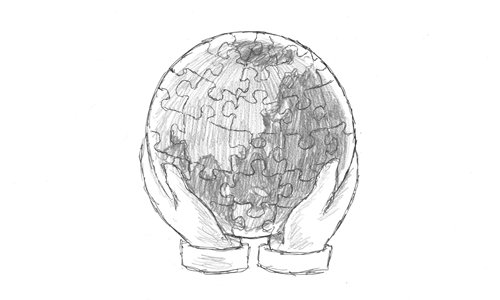HOME >> BUSINESS
Fixing domestic issues key to China-US competition
Source:Global Times Published: 2019/6/5 19:58:39

Illustrations: Peter C. Espina/GT
We are now facing an unprecedented historic change. The essence of change is the competition between big powers - currently China and the US.
This moment will be a major turning point for restructuring international relations and global patterns. The world has become nothing like it was before due to the new round of the scientific and technological revolution. New industrial distributions have redefined the global industrial, supply and value chains. The division of labor continues to evolve. Intermediary goods make up two-thirds of the huge global trade volume and four-fifths of the trade volume in Asia. The world's financial structure has also changed significantly with a more diversified monetary system, although the US dollar accounts for the largest share. But the yuan's internationalization and multiple clearance methods have made progress.
At the turning point, the rivalry will be won based on the victorious country's moral power and the path it has taken. Therefore, the comparison between China and the US is obvious, as China has always stood for cooperation, multilateralism and justice. China decided to build cooperation by pushing forward the Belt and Road Initiative (BRI), gaining an understanding and response from a majority of countries. At the second Belt and Road Summit in Beijing, 127 countries and 29 international organizations signed over 100 BRI cooperation agreements with China. This shows that governments and people all around the world believe China can bring new driving power to enhance the world economy.
The US now has become increasingly closed, conservative, and isolated, letting its economic populism get to an extreme. US President Donald Trump believes in "America First." Making US interests a priority is not wrong, but the problem is the Trump administration is putting American interests above other countries' national interests, global interests and the global rule of law. The world can see the clear contrast. China represents moving forward, opening-up and positive energy. The US, on the other hand, is going backward.
From a historical view, China is in the process of national rejuvenation. The Chinese economy already ranks second in the world with $13.6 trillion in 2018, or about 67 percent of the US GDP. The economic growth rate reached 6.6 percent in 2018. If the GDP still grows around 5 percent in the next 10 years, China will manage to maintain half a century of high growth. It is expected that China's GDP will surpass that of the US before 2030.
China needs to focus on its own matters, knowing that it has a lot of catching up to do. Even if China's GDP can match the US, its GDP per capita would only be one-fourth or one-fifth of that of the US. But justice and time are on the side of China. A majority of the world's countries and people are standing by China's side. China has been keeping promises and opening its markets. In the first five years after joining the WTO, China evaluated the enforcement of WTO promises. Back then, the WTO praised China for fulfilling 100 percent of its promises. The voices saying China failed to keep WTO promises were misleading.
China opened up even more than it promised, and it will continue to open. The financial sector will be completely open by next year.
China is making strides toward opening and has issued strong reform measures. But there are deeper problems waiting to be solved. For instance, we need new measures to attract talent and compete with the US, such as allowing skilled workers to have dual nationalities, providing tax benefits and healthcare benefits and allowing them to gain better access to research materials in China. Therefore, the tussle between China and the US goes beyond the trade conflict. China is facing uncertainties in trade, technology, internet, energy, food and military competition. This requires the country to engage in deeper reform and enhance cooperation between China and other countries, including the US. The mechanisms need to be substantial enough to be appealing. In other words, between China and the US, there should be competition in manufacturing, high-tech, finance, the internet, institutions, policy and strategy.
Only reform and opening can add to China's strategic depth. In addition to development plans for east, west, northeast and central China, we now have the Yangtze River Economic Belt, Beijing-Tianjin-Hebei Integration Initiative and Xiongan New Area, along with other special economic areas that have become China's innovation bases. By forging a leading position in knowledge and talent, the Chinese economy can achieve high quality development. The more strategic depth China seizes, the bigger stake China has to gain in the China-US rivalry, and the more strength it has to catch up.
The article was compiled based on a speech by Chen Wenling, chief economist of the China Center for International Economic Exchanges, on Tsinghua PBCSF Global Finance Forum in May. bizopinion@globaltimes.com.cn
Posted in: INSIDER'S EYE